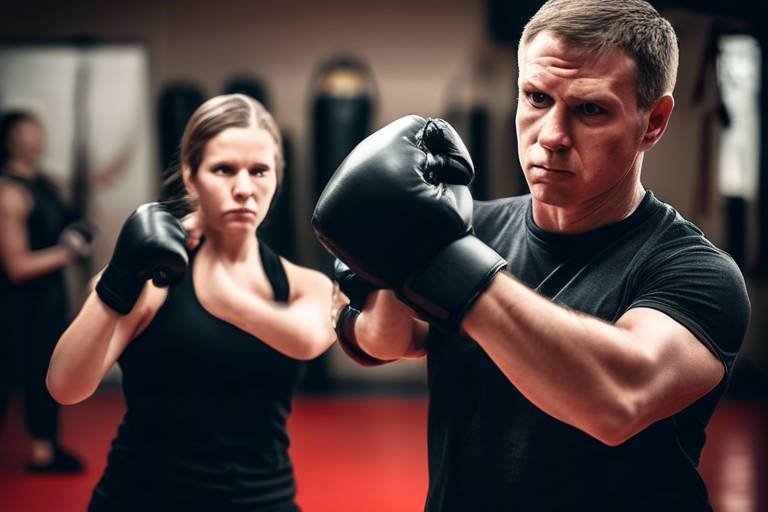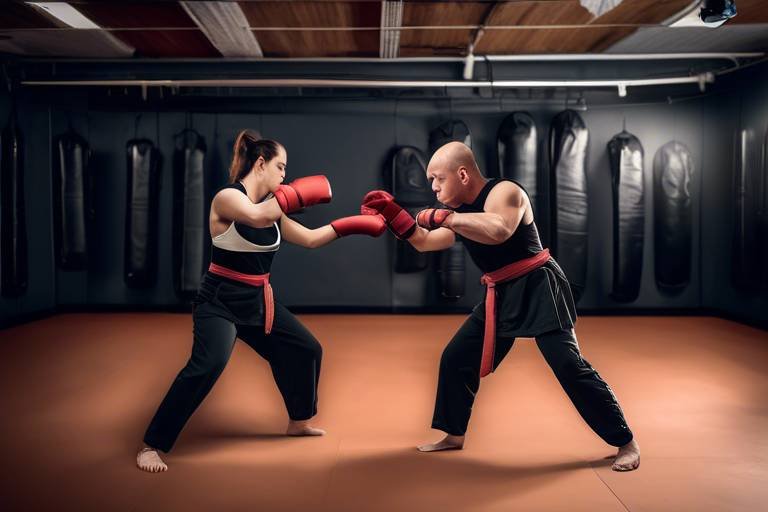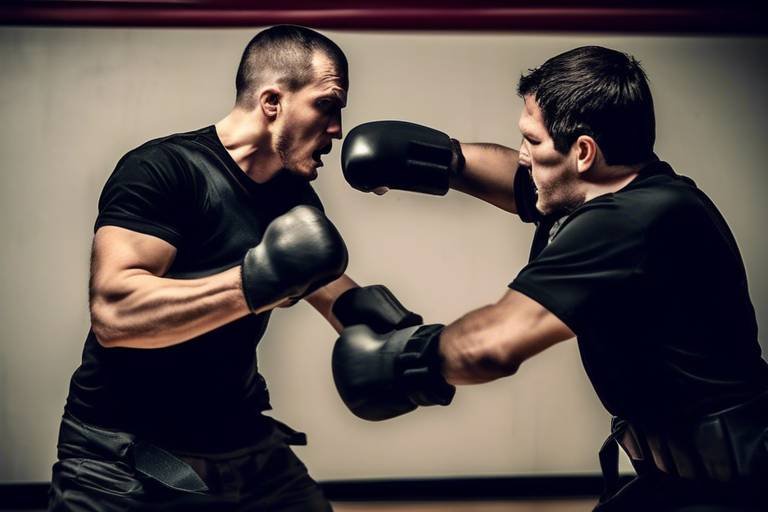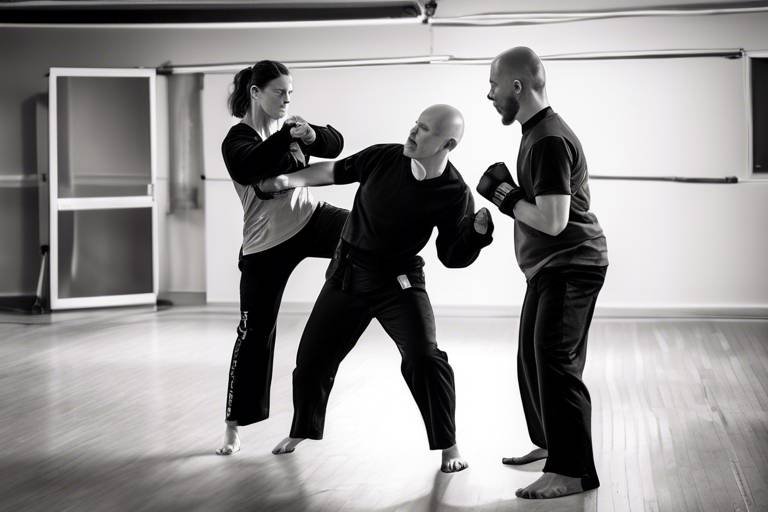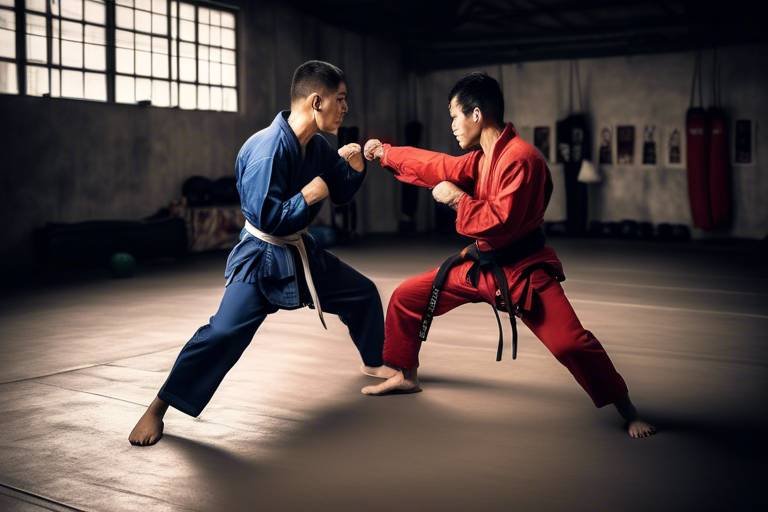Key Factors to Consider When Choosing a Self-Defense Training Class
Choosing the right self-defense training class can feel like finding a needle in a haystack. With so many options available, it’s easy to become overwhelmed. But fear not! This article will guide you through the essential considerations to help you find a program that not only meets your needs but also aligns with your goals and safety requirements. Self-defense isn’t just about learning how to fight; it’s about building confidence, enhancing personal safety, and empowering yourself in various situations. So, let’s dive into the key factors that will make your decision easier and more informed.
Understanding the class structure and curriculum is crucial for effective learning. Different programs offer varying techniques and philosophies, so it’s important to choose one that aligns with your self-defense goals. For instance, some classes focus on traditional martial arts, while others might emphasize modern self-defense techniques that are practical in real-world scenarios. Before enrolling, take the time to review the syllabus and ask questions about the types of techniques taught. Are they applicable to your lifestyle? Do they address the situations you’re most concerned about? These are vital questions to consider.
The qualifications and experience of the instructor can significantly impact your training. A skilled instructor can make all the difference in your learning journey. Look for instructors with credible backgrounds, certifications, and practical experience in self-defense and martial arts. It’s like choosing a guide for a mountain hike; you want someone who knows the terrain and can lead you safely. Don’t hesitate to ask about their training history and teaching philosophy. A good instructor should not only be knowledgeable but also passionate about teaching and helping students grow.
Class size can affect the quality of instruction you receive. Smaller classes often allow for more personalized attention, enhancing your learning experience and ensuring safety during practice. Imagine trying to learn a dance move in a crowded room versus a small, intimate setting; the latter allows for better feedback and guidance. A favorable student-to-instructor ratio means you’ll get more time to practice techniques and receive constructive criticism. Before signing up, inquire about the average class size and how many instructors are present during sessions.
A safe and supportive training environment is vital. Assess the facility's cleanliness, equipment quality, and safety protocols in place to protect students during training sessions. A well-maintained gym with proper mats, protective gear, and first aid supplies speaks volumes about the program’s commitment to safety. Furthermore, consider the atmosphere of the training space. Is it welcoming and encouraging? A positive environment can significantly enhance your motivation and overall experience.
Consider the flexibility of class schedules when choosing a self-defense training program. Options that accommodate your availability can lead to better commitment and consistency in your training. If you have a busy lifestyle, look for schools that offer multiple class times or even online training options. It’s like finding a workout routine that fits seamlessly into your life; the easier it is to attend, the more likely you’ll stick with it. Remember, consistency is key in mastering any skill.
Researching the reputation of the training program through reviews and testimonials can provide insights into the experiences of previous students, helping you make an informed decision. Check online platforms, social media, and local community boards for feedback. A program with a strong positive reputation is usually a good indicator of quality. However, don’t just look at the stars; read the comments! They can reveal a lot about the class dynamics and instructor effectiveness.
Understanding the cost of the training class and available payment options is essential for budgeting. Compare different programs to find one that offers value without compromising quality. Remember, the cheapest option isn’t always the best. Consider what’s included in the price—do they offer gear, unlimited classes, or access to special workshops? A well-structured payment plan can also make it easier to commit to a longer-term program.
Many self-defense schools offer trial classes or introductory offers. Taking advantage of these can help you gauge the class dynamics and instructor effectiveness before making a long-term commitment. It’s like test-driving a car; you wouldn’t buy it without knowing how it handles! Attend a few trial classes to see if the style and atmosphere resonate with you. This is an excellent opportunity to ask questions and observe how the instructor interacts with students.
Finally, consider your personal goals and preferences when choosing a self-defense class. Whether you're seeking fitness, confidence, or practical skills, ensure the program aligns with your objectives. Are you looking to learn self-defense for personal safety, or are you interested in the fitness aspect? Knowing your goals will help you choose the right class. Remember, self-defense is a personal journey, and what works for one person may not work for another.
- What should I wear to a self-defense class? Comfortable athletic wear that allows for movement is ideal.
- Do I need prior experience to join a self-defense class? Most classes welcome beginners, so no prior experience is necessary.
- How long does it take to become proficient in self-defense? Proficiency varies by individual, but regular practice can lead to noticeable improvements in a few months.
- Are self-defense classes suitable for all ages? Yes, there are classes tailored for different age groups and fitness levels.

Class Structure and Curriculum
When diving into the world of self-defense training, understanding the class structure and curriculum is essential. Think of it as laying the foundation for a sturdy house; if the base is weak, everything built on top will be unstable. Different self-defense programs offer a variety of techniques and philosophies, which means that not all are created equal. Some classes might focus on striking techniques, while others emphasize grappling or situational awareness. It’s crucial to choose a program that resonates with your personal self-defense goals.
For instance, if your primary aim is to learn how to protect yourself in real-life situations, you might want to look for classes that incorporate practical scenarios and stress-testing techniques. On the other hand, if you're seeking a more fitness-oriented approach, you may prefer a program that blends self-defense with high-intensity workouts. The curriculum should ideally include:
- Basic Techniques: Fundamental moves that every student should master.
- Advanced Skills: Techniques that build upon the basics for more experienced students.
- Scenario Training: Simulated real-life situations to apply what you've learned.
- Fitness Elements: Exercises that enhance strength, flexibility, and endurance.
Additionally, it's worth considering how the classes are structured. Are they split into beginner, intermediate, and advanced levels? This can significantly affect your learning experience. A well-structured program will allow you to progress at a comfortable pace, ensuring that you grasp each concept before moving on to more complex techniques. Moreover, inquire about the duration of each class and the frequency of sessions. Regular practice is key to mastering self-defense skills, so finding a program that fits your schedule is crucial.
Another aspect to consider is the incorporation of theory alongside practical skills. A comprehensive curriculum should not only focus on physical techniques but also educate students about the psychology of self-defense, including how to avoid confrontations and manage fear in high-stress situations. This holistic approach can empower you to make informed decisions when it matters most.
In conclusion, choosing a self-defense training class with a well-rounded class structure and curriculum is vital for your success. Take the time to research and ask questions about what each program offers. After all, investing in your safety and well-being is one of the most important decisions you can make!
Q1: How long does it take to become proficient in self-defense?
A1: Proficiency can vary based on individual commitment and practice frequency. Generally, consistent training over several months will yield noticeable improvements.
Q2: Do I need any prior experience to join a self-defense class?
A2: No prior experience is usually necessary. Most classes cater to beginners and will start with the basics.
Q3: What should I wear to a self-defense class?
A3: Comfortable athletic wear is recommended. Ensure you have proper footwear that allows for movement.
Q4: Are self-defense classes safe?
A4: Yes, reputable classes prioritize safety and have protocols in place to minimize risks during training.
Q5: Can self-defense training help with confidence?
A5: Absolutely! Many students report increased confidence and self-esteem as they learn new skills and techniques.

Instructor Qualifications
When it comes to self-defense training, the instructor's qualifications are paramount. You wouldn’t want to learn how to swim from someone who can’t float, right? The right instructor can make all the difference in your training experience, providing not just knowledge but also the confidence to apply what you learn. First and foremost, look for instructors with credible backgrounds in self-defense or martial arts. This could mean they hold certifications from recognized organizations or have extensive experience in various disciplines, such as karate, judo, or even Brazilian jiu-jitsu.
Additionally, practical experience is crucial. An instructor who has participated in competitions, real-life self-defense situations, or has a background in law enforcement can offer insights that go beyond textbook knowledge. They can share real-world applications of techniques, helping you to understand not just the 'how' but also the 'when' and 'why' behind each move.
Moreover, consider the instructor's teaching style. Are they approachable and encouraging? Do they foster a supportive environment? It’s essential that you feel comfortable asking questions and expressing concerns. A good instructor should be able to adapt their teaching methods to suit the needs of their students, ensuring that everyone, regardless of skill level, can learn effectively.
To help you evaluate potential instructors, here’s a quick table summarizing key qualifications to look for:
| Qualification | Importance |
|---|---|
| Certification in Martial Arts | Validates expertise and knowledge |
| Practical Experience | Enhances teaching with real-world applications |
| Teaching Experience | Indicates ability to convey techniques effectively |
| Positive Reviews/Testimonials | Reflects student satisfaction and success |
Lastly, don’t hesitate to ask for references or to observe a class before committing. This can provide a clearer picture of the instructor's capabilities and the overall class atmosphere. Remember, choosing the right instructor is like picking the right coach for a sports team; the right fit can elevate your skills and boost your confidence, while the wrong choice can leave you feeling lost and frustrated. So, take your time, do your research, and find someone who inspires you to learn and grow in your self-defense journey.
If you have more questions about choosing the right self-defense training class, here are some frequently asked questions to consider:
- What qualifications should I look for in a self-defense instructor? Look for certifications, practical experience, and positive student feedback.
- How can I assess the instructor's teaching style? Observing a class or asking for a trial lesson can help you gauge their approach.
- Is it important to have a small class size? Yes, smaller classes often provide more personalized attention and a better learning environment.
- What if I have specific self-defense goals? Make sure to communicate your goals to the instructor to ensure the program aligns with your needs.

Class Size and Student-to-Instructor Ratio
When it comes to self-defense training, class size and the student-to-instructor ratio are two key factors that can heavily influence your learning experience. Imagine stepping into a class where you're one of twenty students, all vying for the instructor’s attention. It can feel overwhelming, right? In contrast, a smaller class size allows for a more intimate learning environment where you can receive personalized feedback and guidance.
Typically, classes with fewer students provide an opportunity for instructors to focus on individual needs, ensuring that techniques are not only demonstrated but also practiced correctly. You might wonder, "How does this really impact my training?" Well, think of it this way: if you're trying to learn a new dance move in a crowded room, it’s easy to get lost in the shuffle. However, in a smaller setting, you can practice the move multiple times with direct supervision, making it easier to grasp the concept.
Here’s a quick breakdown of how class size can affect your training:
| Class Size | Benefits | Drawbacks |
|---|---|---|
| Small (1-5 students) |
|
Limited availability of classes |
| Medium (6-15 students) |
|
Potential for less individual feedback |
| Large (16+ students) |
|
Less personalized attention, higher risk of injury |
Moreover, the ideal student-to-instructor ratio is generally around 5:1 or lower for optimal learning. This means that for every five students, there should ideally be one instructor. This ratio allows for adequate supervision and ensures that everyone receives the attention they need to refine their skills. If you find a school that boasts a low student-to-instructor ratio, consider it a significant advantage in your self-defense journey.
In conclusion, as you embark on your quest for the right self-defense class, keep in mind the importance of class size and the student-to-instructor ratio. A smaller class can enhance your learning experience, making it easier for you to absorb techniques and practice them safely. So, don’t hesitate to ask about these factors when researching potential training programs. Your safety and skill development depend on it!

Training Environment and Safety Measures
When it comes to self-defense training, the training environment and safety measures are paramount. Imagine stepping into a dojo or training facility where the atmosphere is not only welcoming but also inviting—that’s the kind of place you want to be. A well-maintained environment can significantly enhance your learning experience and ensure you feel comfortable while honing your skills. Look for facilities that are clean, well-lit, and equipped with proper mats or flooring to minimize the risk of injury. The last thing you want is to worry about tripping over a loose floor tile while practicing a crucial technique!
Safety measures should also be a top priority. Instructors should be trained in first aid and CPR, ready to handle any minor injuries that may occur during training. It's essential to ask about the facility's safety protocols. For example, do they have a plan in place for emergencies? Are there sufficient safety equipment and mats available? These factors can make a world of difference in how secure you feel during your training sessions.
Furthermore, a supportive training environment fosters camaraderie among students. It’s not just about learning how to throw a punch or escape a hold; it's about building a community where everyone looks out for one another. A strong sense of teamwork can boost your confidence and motivate you to push through challenges. Instructors should encourage this atmosphere by promoting respect and safety among all students. After all, you’re not just learning to defend yourself; you’re also developing relationships that can last a lifetime.
To summarize, here are some key elements to consider regarding the training environment and safety measures:
- Cleanliness: Ensure the facility is well-maintained and hygienic.
- Equipment Quality: Check that the training mats and gear are in good condition.
- Emergency Protocols: Inquire about the facility's emergency procedures and first aid readiness.
- Instructor Support: Look for instructors who prioritize safety and foster a supportive atmosphere.
Ultimately, your training environment should inspire you to learn and grow while keeping safety at the forefront. When you feel secure in your surroundings, you can fully focus on mastering the techniques and strategies that will empower you in real-life situations. So, take the time to visit potential training facilities and assess their environments—your safety and comfort should always come first!
Q1: What should I look for in a self-defense training environment?
A1: Look for cleanliness, proper equipment, and a supportive atmosphere. Ensure that instructors prioritize safety and have emergency protocols in place.
Q2: Are safety measures important in self-defense training?
A2: Absolutely! Safety measures are crucial to prevent injuries and ensure a secure learning environment. Instructors should be trained in first aid and CPR.
Q3: How can I assess the quality of a self-defense training facility?
A3: Visit the facility, observe a class, and ask about their safety protocols and instructor qualifications. Pay attention to the cleanliness and equipment quality as well.

Flexibility of Class Schedules
When it comes to choosing a self-defense training class, one of the most crucial factors to consider is the . Life can be unpredictable, and finding a program that fits seamlessly into your busy routine is essential for maintaining motivation and consistency in your training. Imagine signing up for a class that meets every Tuesday at 6 PM, only to realize that you have a standing commitment during that time. Frustrating, right? That's why it's important to seek out programs that offer a variety of scheduling options.
Many self-defense schools understand the diverse needs of their students and provide classes at different times throughout the week. This flexibility can include morning, afternoon, and evening sessions, allowing you to choose a time that works best for you. Some schools even offer weekend classes, which can be a game-changer for those with demanding weekday schedules. By having multiple options, you can avoid the stress of juggling commitments and focus on your training instead.
Additionally, consider whether the program allows for drop-in classes or has a flexible attendance policy. This can be particularly beneficial for individuals with fluctuating schedules, as it gives you the freedom to attend when you can. Some schools may even offer online classes or hybrid models, combining in-person training with virtual sessions. This blend can provide the best of both worlds, allowing you to learn at your own pace while still receiving guidance from experienced instructors.
Here’s a quick overview of what to look for in terms of flexibility:
- Variety of Class Times: Check if the school offers classes at different times throughout the week.
- Weekend Options: Weekend classes can be a lifesaver for those with busy weekdays.
- Drop-in Classes: Flexibility to attend classes without a strict schedule can make training more accessible.
- Online/Hybrid Classes: Consider programs that offer online training to complement your in-person sessions.
Ultimately, the key is to find a self-defense training class that aligns with your lifestyle. By prioritizing flexibility in class schedules, you can ensure that your self-defense journey is not only effective but also enjoyable. After all, the best training is the training that fits into your life, allowing you to learn, grow, and build confidence without feeling overwhelmed.
Q: What if I can’t make it to my scheduled class?
A: Many self-defense schools offer flexible attendance policies, allowing you to attend drop-in classes or make up missed sessions. It's best to check with the instructor about their specific policies.
Q: Are there online options available for self-defense training?
A: Yes! Many schools now offer online or hybrid classes, making it easier to train from home or complement your in-person sessions.
Q: How do I know if a class schedule will work for me?
A: Before committing, review the class schedule and see if it fits your lifestyle. You can also consider attending a trial class to gauge the timing and atmosphere.

Reputation and Reviews
When it comes to selecting the right self-defense training class, the reputation of the program can play a pivotal role in your decision-making process. After all, you want to invest your time and money in a program that has proven to deliver results. So, how do you gauge the reputation of a self-defense class? One of the best ways is to look at reviews and testimonials from past students. These insights can provide a clear picture of what you can expect from the training. You might be wondering, "Where do I find these reviews?" Well, platforms like Google, Yelp, and even social media are treasure troves of information where students share their experiences.
Moreover, consider the qualifications of the instructors and the overall ethos of the training facility. A program that has been around for a while and has a solid track record is often more reliable than a new, untested one. Look for programs that have received accolades or have been recognized in the community. If a school has been featured in local news articles or has partnerships with well-known organizations, it’s a good indicator that they are respected in the field.
Another important factor is to check if the school has a strong online presence. A well-maintained website and active social media accounts can reflect a program's commitment to its students and the community. You can also look for video testimonials or case studies that showcase student progress and success stories. These can be incredibly compelling and can give you a better understanding of the class dynamics.
To further assist you in assessing the reputation of potential training programs, here’s a simple
| Factor | What to Look For |
|---|---|
| Online Reviews | Look for a high average rating and read multiple reviews for a balanced perspective. |
| Instructor Credentials | Check for certifications, years of experience, and teaching philosophy. |
| Community Recognition | Awards, partnerships, or features in local media can indicate a solid reputation. |
| Trial Classes | Programs that offer trial classes allow you to experience the training before committing. |
Finally, don’t hesitate to reach out to current or former students. Asking them about their experiences can provide invaluable insights that you won’t find in reviews. A simple chat can reveal the class atmosphere, instructor approachability, and overall student satisfaction. Remember, the goal is to find a program that not only meets your self-defense needs but also fosters a positive and encouraging learning environment.
- How important are reviews when choosing a self-defense class?
Reviews are crucial as they provide firsthand accounts of other students’ experiences, helping you gauge the quality of instruction and the training environment. - What should I do if I find negative reviews?
Consider the context of the negative reviews. Look for patterns and see how the instructor or school responded to feedback. Not all negative feedback is a deal-breaker. - Can I trust online reviews?
While many online reviews are genuine, always cross-reference multiple sources to get a balanced view of the training program.

Cost and Payment Options
When it comes to choosing a self-defense training class, understanding the cost and available payment options is crucial for making a well-informed decision. After all, you want to ensure that you're getting the best value for your investment while also not breaking the bank. The cost of self-defense classes can vary widely based on several factors, including the type of program, the instructor's experience, and the location of the training facility. Typically, you might find classes ranging from as low as $10 per session to upwards of $200 for specialized programs.
One important aspect to consider is whether the program offers package deals or membership options. Many schools provide discounts for students who commit to a series of classes upfront. For example, a typical pricing structure might look something like this:
| Package Type | Sessions Included | Cost |
|---|---|---|
| Drop-In Class | 1 | $20 |
| 5-Class Package | 5 | $90 |
| 10-Class Package | 10 | $160 |
| Monthly Membership | Unlimited | $150 |
In addition to class fees, you should also be aware of any additional costs that may arise. For instance, some programs may require you to purchase specific gear or uniforms to participate in classes. This could include items like gloves, pads, or even uniforms that are essential for certain martial arts styles. It’s always a good idea to inquire about these potential costs upfront to avoid any surprises later on.
Another factor to consider is the payment options available. Many training facilities offer flexible payment plans, allowing you to pay in installments rather than a lump sum. This can make it easier to budget for your training without feeling overwhelmed. Additionally, some facilities may accept various forms of payment, including credit cards, cash, or even digital payment methods, which can add an extra layer of convenience.
In summary, when evaluating the cost and payment options for self-defense training, it's essential to consider the overall value of the program, the potential for discounts, and the flexibility of payment methods. By doing your homework and comparing different options, you can find a class that not only fits your budget but also meets your self-defense training needs.
- What is the average cost of self-defense classes? The average cost can range from $10 to $200 per class, depending on various factors.
- Are there any additional fees? Yes, some programs may require you to purchase specific gear or uniforms.
- Do self-defense classes offer payment plans? Many facilities offer flexible payment options, including installment plans.
- Can I try a class before committing? Yes, many schools offer trial classes or introductory rates to help you decide.

Trial Classes and Introductory Offers
When it comes to selecting the right self-defense training class, nothing beats the opportunity to experience it firsthand. This is where trial classes and introductory offers come into play. They provide a golden chance for potential students to dip their toes into the world of self-defense without making a long-term commitment. Imagine trying on a pair of shoes before buying them; this is exactly what trial classes allow you to do with your training. You wouldn't want to invest time and money into a program that doesn't fit your needs, right?
Trial classes typically allow you to attend a session for free or at a reduced rate, giving you a taste of what the program has to offer. During these sessions, you can assess the instructor's teaching style, the class dynamics, and the overall atmosphere of the training environment. Are the students engaged? Is the instructor approachable and knowledgeable? These are crucial factors that can make or break your self-defense journey. Furthermore, trial classes often give you the chance to interact with current students, allowing you to glean insights from their experiences.
Many self-defense schools also offer special introductory packages that may include a series of classes at a discounted rate. This can be an enticing option for those looking to commit but still wanting to explore different programs. Such offers can help you save money while allowing you to evaluate whether the class meets your expectations over a longer period. However, before jumping on these deals, it's wise to do some homework. Consider asking the following questions:
- What does the trial class include? Is it a full class experience or just a brief overview?
- Are there any hidden fees if you decide to enroll after the trial?
- What is the duration of the introductory offer?
In addition, pay attention to the terms and conditions associated with these trial classes and offers. Some schools might require you to sign a waiver or agree to certain policies before participating. Understanding these details can save you from any surprises down the line.
Ultimately, trial classes and introductory offers serve as a stepping stone towards finding the right self-defense training program for you. They not only help you gauge the quality of the instruction but also allow you to reflect on your own comfort level within the class. So, take advantage of these opportunities; they can be the key to unlocking your self-defense potential!
Here are some common questions that potential students often have when considering trial classes and introductory offers:
- How long do trial classes typically last? Most trial classes last between 45 minutes to an hour, giving you enough time to get a feel for the program.
- Can I attend multiple trial classes at different schools? Absolutely! It's encouraged to explore various options to find the best fit for you.
- What should I wear to a trial class? Comfortable athletic wear is usually recommended, along with appropriate footwear.
- Are trial classes suitable for all skill levels? Yes, most self-defense programs cater to beginners as well as experienced practitioners.

Goals and Personal Preferences
When it comes to choosing a self-defense training class, understanding your personal goals and preferences is absolutely essential. Think about what you hope to achieve through your training. Are you looking to boost your fitness levels, gain more confidence, or acquire practical skills that you can use in real-life situations? Each of these objectives can lead you down a different path in terms of the type of class you should choose.
For instance, if your primary goal is to get fit, you might want to consider classes that incorporate high-intensity workouts, such as kickboxing or mixed martial arts. These classes not only teach self-defense techniques but also provide a fantastic cardiovascular workout that can help you shed pounds and build muscle. On the other hand, if your focus is on practical self-defense skills, you might lean towards programs that emphasize techniques used in real-life scenarios, such as Krav Maga or Brazilian Jiu-Jitsu.
Another important aspect to consider is your learning style. Do you thrive in a competitive environment, or do you prefer a more collaborative and supportive atmosphere? Some individuals find motivation in sparring and competition, while others may feel more comfortable in a class that emphasizes teamwork and personal growth. This preference can greatly influence your enjoyment and commitment to the training.
Moreover, think about the time commitment you are willing to make. Some classes may require more frequent attendance or longer sessions, while others might offer shorter, more flexible options. Being honest with yourself about how much time you can realistically dedicate will help you choose a program that fits seamlessly into your lifestyle.
Lastly, don’t forget to consider the location of the training facility. A convenient location can significantly impact your ability to attend classes consistently. If the class is too far from your home or workplace, you might find it challenging to stay committed. Look for a place that is easily accessible, so you can make self-defense training a regular part of your routine.
In summary, aligning your self-defense training choice with your personal goals and preferences is crucial. This alignment not only enhances your learning experience but also keeps you motivated and engaged. Take the time to reflect on what you want to achieve, and don’t hesitate to ask instructors about how their classes can cater to your specific needs.
- What should I look for in a self-defense class? Look for a class that aligns with your personal goals, offers qualified instructors, and provides a safe training environment.
- How important is instructor experience? Very important! An experienced instructor can provide valuable insights and ensure that you learn techniques effectively and safely.
- Can I try a class before committing? Yes! Many schools offer trial classes or introductory offers that allow you to experience the training before making a long-term commitment.
- What if I have specific fitness goals? Communicate your fitness goals with the instructor. They can guide you to classes that emphasize physical conditioning alongside self-defense techniques.
Frequently Asked Questions
- What should I look for in the class structure and curriculum?
When selecting a self-defense training class, it's important to consider the variety of techniques taught and whether they align with your personal goals. Look for programs that offer a well-rounded curriculum, combining practical skills with theoretical knowledge. This ensures you get both the physical training and the mental preparation needed for real-life situations.
- How important are instructor qualifications?
Instructor qualifications are crucial for effective learning. A knowledgeable instructor with credible certifications and real-world experience can significantly enhance your training experience. They should not only be skilled in self-defense techniques but also have the ability to teach and motivate students effectively.
- Does class size really matter?
Absolutely! The size of the class can greatly influence the quality of instruction you receive. Smaller classes often mean more personalized attention from the instructor, which can enhance your learning and ensure that you practice techniques safely and correctly.
- What safety measures should I expect in a training environment?
A safe training environment is essential for effective learning. Look for facilities that maintain cleanliness and have quality equipment. Additionally, inquire about the safety protocols in place, such as first aid availability and emergency procedures, to ensure you feel secure while training.
- Are flexible class schedules important?
Yes, flexibility in class schedules can make a huge difference in your commitment to training. Programs that accommodate your availability allow you to attend classes consistently, which is key to progressing in your self-defense skills. Make sure to choose a program that works with your lifestyle.
- How can I assess the reputation of a training program?
Researching the reputation of a training program is vital. Look for reviews and testimonials from previous students. These insights can help you gauge the overall experience and effectiveness of the program, giving you a clearer picture of what to expect.
- What should I consider regarding cost and payment options?
Understanding the cost of training and available payment options is essential for budgeting. Compare different programs to find one that offers good value without sacrificing quality. Be sure to inquire about any hidden fees or additional costs that may arise.
- Are trial classes worth it?
Definitely! Many self-defense schools offer trial classes or introductory offers that allow you to experience the class dynamics and instructor effectiveness without a long-term commitment. This is a great way to determine if the program is a good fit for you.
- How do I align my personal goals with a self-defense class?
When choosing a self-defense class, reflect on your personal goals—whether it's fitness, building confidence, or learning practical skills. Make sure the program you choose aligns with these objectives to ensure a fulfilling training experience that meets your needs.

